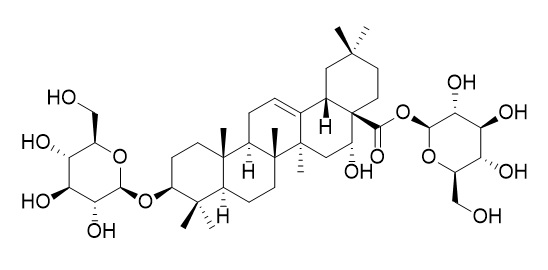Eclalbasaponin I
Eclalbasaponin I has anti-oxidative, and antitumor activities, it reduces oxidative stress-induced neural cell death by autophagy activation, it can dose-dependently inhibit the proliferation of hepatoma cell smmc-7721 with the IC(50) value of 111.1703 ug/ml.
Inquire / Order:
manager@chemfaces.com
Technical Inquiries:
service@chemfaces.com
Tel:
+86-27-84237783
Fax:
+86-27-84254680
Address:
1 Building, No. 83, CheCheng Rd., Wuhan Economic and Technological Development Zone, Wuhan, Hubei 430056, PRC
Providing storage is as stated on the product vial and the vial is kept tightly sealed, the product can be stored for up to
24 months(2-8C).
Wherever possible, you should prepare and use solutions on the same day. However, if you need to make up stock solutions in advance, we recommend that you store the solution as aliquots in tightly sealed vials at -20C. Generally, these will be useable for up to two weeks. Before use, and prior to opening the vial we recommend that you allow your product to equilibrate to room temperature for at least 1 hour.
Need more advice on solubility, usage and handling? Please email to: service@chemfaces.com
The packaging of the product may have turned upside down during transportation, resulting in the natural compounds adhering to the neck or cap of the vial. take the vial out of its packaging and gently shake to let the compounds fall to the bottom of the vial. for liquid products, centrifuge at 200-500 RPM to gather the liquid at the bottom of the vial. try to avoid loss or contamination during handling.
Drug Test Anal.2018, 10(10):1579-1589
ACS Pharmacol Transl Sci.2024, 7(2):395-405.
Oxid Med Cell Longev2019, 9056845:13
Phytochemistry Letters2017, 449-455
Anal Bioanal Chem.2023, 415(9):1641-1655.
RSC Adv.2018, 32621-32636
Ajou University2024, 4688116
J Nat Med.2020, 74(3):550-560.
Korean J. Medicinal Crop Sci.2022, 30(2):117-123.
J Korean Soc Food Sci Nutr2023, 52(11):1101-1110
Related and Featured Products
Food Chem Toxicol. 2012 Nov;50(11):4016-22.
Eclipta prostrata L. phytochemicals: isolation, structure elucidation, and their antitumor activity.[Pubmed:
22902823]
Eclipta prostrata L., (Asteraceae), is used in China for both food and medicine purposes. This research is concerned with the isolation and purification of phytochemical constituents from the aerial parts of E. prostrata, using gradient solvent fractionation, macroporous resin, silica gel, Sephadex LH-20 and ODS columns, and TLC analyses.
METHODS AND RESULTS:
Four fractions (water, 30% ethanol, 60% ethanol and 90% ethanol) were obtained. Four compounds, wedelolactone (I), Eclalbasaponin I (II), luteolin (III) and luteolin-7-O-glucoside (IV) were purified and their structures were identified by the interpretation of spectroscopic analyses including MS, (1)H and (13)C NMR. Antitumor activities of extracts (total fraction), four fractions and the isolated compounds were assessed using hepatoma cell smmc-7721 as an in vitro assay system. The 30% ethanol fraction and Eclalbasaponin I dose-dependently inhibited the proliferation of hepatoma cell smmc-7721 with IC(50) values of 74.2399 and 111.1703 μg/ml, respectively, more strongly compared with 5-fluorouracil positive control group with the IC(50) value of 195.3131 μg/ml. Antitumor activities of other fractions and compounds were lower than positive control.
CONCLUSIONS:
These results suggested that some specific compounds or extracts from E. prostrata are potential sources of natural anti-tumor materials and worthy of further study.
Biomed Pharmacother. 2018 Jan;97:152-161.
Eclalbasaponin I from Aralia elata (Miq.) Seem. reduces oxidative stress-induced neural cell death by autophagy activation.[Pubmed:
29091860 ]
Oxidative stress has been proposed to contribute to DNA damage and is involved in many neurodegenerative diseases. It has been reported that Aralia elata (Miq.) Seem. (A. elata) exhibits an anti-oxidative effect but the mechanisms underlying this protective effect are still unclear.
METHODS AND RESULTS:
In this study, six known triterpene saponins were isolated from the buds of A. elata, a well-known medicinal and edible plant in Northeast China. Subsequently, the anti-oxidative effects of all six triterpene saponins were screened by H2O2-induced damage in human neuronblastoma SH-SY5Y cells. Compound 6, also known as Eclalbasaponin I (EcI), was the most potent. Furthermore, the mechanism by which EcI combats H2O2-induced oxidative stress was investigated. The data suggested that EcI could down-regulate apoptosis induction and the generation of reactive oxygen species (ROS) induced by 200μM H2O2 in SH-SY5Y cells. Moreover, EcI increased the activities of antioxidant enzymes such as superoxide dismutase (SOD) and glutathione peroxides (GSH-Px), reduced the levels of malondialdehyde (MDA) to restore the antioxidant defense system, and activated the nuclear factor E2-related factor (Nrf2)/heme oxygenase 1 (HO-1) pathway to combat oxidative stress. In addition, EcI also promoted autophagy during this process. Interestingly, the protective effect was remarkably reversed by autophagy inhibitors, bafilomycin A1 (Baf) or 3-Methyladenine (3-MA).
CONCLUSIONS:
These results demonstrate that autophagy is contribute to the protective effect of EcI. Collectively, our findings provide a new insight into the potential protective effect of EcI by focusing on the role of autophagy.



